the place where Paleontology and Paleoanthropology meets Philately
The History of Megaloceros giganteus (Irish Elk/Giant Deer) Discovery
There are many articles, books and videos about the animal, but there is limited information about the history of its discovery. This article intends to close the gap and list philatelic items of this magnificent animal.Megaloceros giganteus, also called Giant Deer, extinct species of deer, characterized by immense body size and wide antlers, commonly found as fossils in Pleistocene deposits in Europe and Asia (the Pleistocene Epoch began 2.6 million years ago and ended about 11,700 years ago)ENCYCLOPADIA BRITANNICA
This Giant Deer, contemporary of the Woolly Mammoth and the Woolly Rhinoceros, was indeed a giant, as males were up to 700 kg in weight and stood about 2.1 meters tall at the withers. They carried proportionally huge antlers with a maximum tip to tip length of 3.7 meters. The antlers were up to 50 kg in weight, which are the largest antlers of any known deer. Similar to modern deer, the female animals were smaller and antlerless, while males replaced their antlers every mating season.

A small population of Megaloceros giganteus survived in the Siberian region of Russia until 7,000 years ago (probably even to more recent time).
 |
| Hunting scene from Paleolithic on postage stamps of Transnistria, 1996. MiNr.: N/A, Scott: N/A. |
These exquisite paintings depict Megaloceros giganteus with speckled coats and dark shoulder hair that accentuated a distinctive hump. Due to the fact that the hump does not show in fossils, the cave art really helps with reconstruction of the animal. Some remains show evidence of butchery by Neanderthals and Homo sapiens, so over-hunting by humans is a possible contributory factor to their extinction, along with climate change and habitat loss.
The animal is often called the Irish Elk, however it is not an elk, but a deer, nor it is unique to Ireland.
According to recent research Megaloceros giganteus is most closely related to present-day fallow deer (Dama dama).
Although the "Giant Deer" ranged from mainland Europe through Siberia to northern Africa, almost all of the surviving skeletons and skulls are Irish. This is due to the unique composition of Irish bogs. It seems the unfortunate top-heavy beasts regularly came to sticky ends mired in muddy lakes. The bog grew over them, burying their remains, until they were uncovered by turf-cutters.
Most Megaloceros giganteus fossils found to date are of male animals. The female skeletons are likely misidentified as “cows” that had fallen in the bogs and lakes.
The Natural History Museum in Dublin, also called Dublin's “Dead Zoo”, houses 10 skeletons of the “Irish Elk” in their collection, three of which are mounted for display at the entrance, and the remains of 250 others are kept in storage rooms.

The skeleton on the right at the front entrance of the museum is the first Megaloceros giganteus skeleton found in Ireland.
 |
| The oldest recorded find of a “Giant Deer” in Ireland dates to 1588. Image credit: "Megaloceros, the ice age giant deer of Ireland and some Dutch connections", by Nigel T Monaghan. |
 |
| The drawing of Thomas Molyneux from 1697. "A discourse concerning the large horns frequently found under ground in Ireland, concluding from them that the great American deer, called a moose, was formerly common in that island: with remarks on some other things natural to that country". Philosophical Transactions of the Royal Society, London 19-227, p. 489-512. |
 |
| Antlers of Megaloceros giganteus described by Thomas Molyneux in 1697 among others on display at Hampton Court. Image credit: "Style Wanderings" (the article does not exist anymore). |
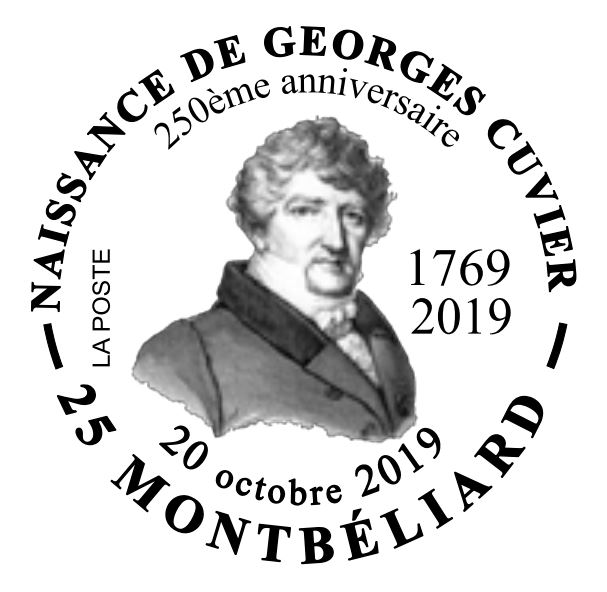 |
| Georges Cuvier on commemorative postmark of France 2019 |
 |
| The image is from “Essay on the THEORY OF THE EARTH, BY Baron G. Cuvier” published in 1827. |

 |
| Megaloceros giganteus on "Centenaries of Manx Museum" stamp of the Isle of Man 1986 and reconstruction of "Irish Elk" on “Prehistoric animal” stamp of Ireland 1999. |
 |
| Skull and antlers of Megaloceros giganteus on "150th Anniversary of the Natural History Museum" stamp of Ireland 2007, MiNr. 1800, Scott Nr. 1759. |
 |
| The Giant Deer drawings from a book of John Hart “A description of the skeleton of the fossil deer of Ireland, Cervus megaceros”, published in 1825. |
 |
| One of the first reconstructions of Megaloceros giganteus - illustration from a book “Extinct Monsters” by HENRY NEVILLE HUTCHINSON, published in 1896 in London |
 |
| Page 20 of "A catalogue of the anatomical and zoological museum of Joshua Brooks", published by British naturalist Joshua Brooks in 1828 with correctly spelled “Megaloceros” (marked by red) |
 |
| Zoological exhibit at the Siberian-Ural Scientific and Industrial Exhibition in 1887. The skeleton of Megaloceros giganteus, on the left. Mounted, stuffed animals on the right. Image credit: zavodfoto.livejournal |
 |
| Postcard: skeletons of Megaloceros and Mammoth in the Museum of the Ural Society of Natural History Lovers in Yekaterinburg. |
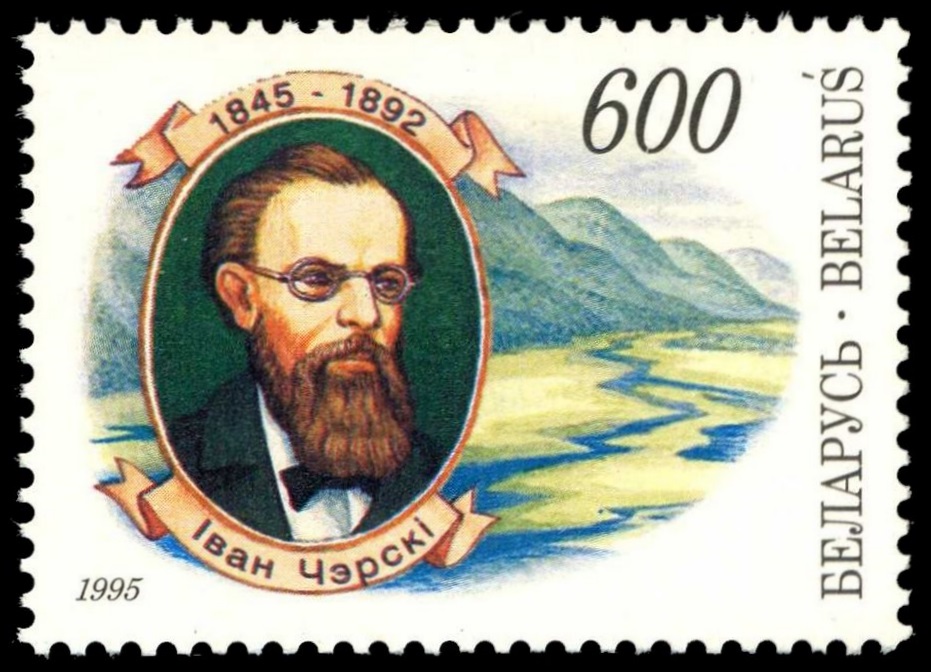 |
| Jan Czersky on postage stamp of Belarus 1995, MiNr.: 92, Scott: 113. |
The oldest fossil of Megaloceros giganteus that survived till today is a braincase and part of antlers that was found in Bad Cannstatt village near Stuttgart in Germany, in 1600. As it was different from any known ruminant, it was kept in a curiosity cabinet. Nowadays it is on display at the Natural History Museum in Stuttgart.
It was only in 1697 when the Irish aristocratic scholar Thomas Molyneux identified large antlers from Dardistown, Dublin — which were apparently commonly unearthed in Ireland, as belonging to the “Great Irish Elk”. Molyneux described the antlers:
Such another Head, with both the Horns entire was found some Years since by
one Mr. Van Delure in the County of Clare, buried Ten Foot under Ground in a fort of Marle,
and were presented by him to the late Duke of Ormond, then Lord Lieutenant of Ireland, who valued
them so highly for their prodigious largeness, that he thought them not an unfit Present for
the King, and sent them for England to King Charles the Second, who ordered them to be set
up in the Horn-Gallery at Hampton-Court; where they may still be seen among the rest of the
large Heads both of Stags and Bucks that adorn that Place, but this so visually exceeds the
largest of them, that the rest appear to lose much of their curiosity.
It was a common belief at this time, that a God who created the world and all that was in it would not allow his creations to disappear from existence, therefore he wrote:
That no real species of living creatures is so utterly extinct, as to be lost entirely out of the
World, since it was first created, is the opinion of many naturalists; and 'tis grounded on so
good a principle of Providence taking care in general of all its animal productions, that it
deserves our assent
Only in 1812 French scientist Georges Cuvier, who first developed the theory of extinction caused by catastrophes responsible for wiping out the Earth’s species
to prove the existence of a world previous to ours, destroyed by some kind of catastrophe, documented that the "Irish Elk" along with other fossil vertebrates such as the mammoth, did not belong to any living species of mammal, declaring the “Irish Elk” as the most famous of all fossil ruminants:
in some parts of the country they have been found so often, that far from being regarded as objects of any extraordinary interest, they have been either thrown aside as lumber, or applied to the commonest economical uses.
It took over a century, since Thomas Molyneux identified the antlers, until an entire skeleton of Megaloceros giganteus was uncovered. Curiously, it was uncovered not in Ireland, but on the Isle of Man.
The first, nearly, complete specimen of the species to be found was discovered on 14th August 1819 by a blacksmith Thomas Kewish in a marl pit at Loughan Ruy, a basin on the Ballaugh gravel fan, on the Isle of Man.
Marl is defined as an open-water mud rich in calcium carbonate deposited principally by the plant Chara. Such a mud gives clear evidence of the former existence of a lake in whose calcium-rich deposits bone would be readily preserved.
Only a few bones were missing in the skeleton, most notably the pelvis. Kewish used a large horse pelvis, among a few other things, to fill in the gaps.John Stevens Henslow, British botanist and geologist, best remembered as friend and mentor to his student Charles Darwin, who was doing some research on the island at the time of the discovery, mentioned in one of his letters that a local blacksmith took a horse skeleton as model for his reconstruction of the "Elk" and made it with a great accuracy.
The discovery generated a lot of interest, therefore Kewish entered into a partnership with James Taubman, the tenant of the field where the fossils came from. They placed the mounted skeleton on display and charged admission to view it. As it was a big success on the island – many inhabitants came to see the unusual, giant animal, the duo developed a plan to take the skeleton on tour to Scotland and England. However, the Duke of Athol, who was the Queen’s Representative on the Isle of Man, later claimed the fossils as Lord of the Manor. After a lawsuit, the "Great Elk" came into the Duke’s possession. The Duke of Athol later donated the specimen to the Museum of the University of Edinburg. The skeleton was later transferred with other specimens to the National Museum of Scotland at Chambers St, Edinburgh.
The only other skeleton of Megaloceros giganteus found on the Isle of Man was excavated at Closey-Garey, St. John's in 1897 and it remains on display at the Manx Museum in Douglas. The skeleton appeared on postage stamp of the Isle of Man in 1986 (see on the right).
The first, nearly complete, skeleton of Megaloceros giganteus found in Ireland is the skeleton found near Lough Gur, at Castle- farm, Rathcannon near Limerick city in 1824, in a marl layer underlying peat.
It was donated by William Wray Maunsell, the Archdeacon of Limerick to the Royal Dublin Society.
The specimen was reconstructed by Irish surgeon John Hart, who described and illustrated it in a Booklet published in 1825.
The skull and antler of this skeleton appears on the Irish postage stamp commemorating the 150th Anniversary of the Natural History Museum in Dublin in 2007 (see on the right). It is also one of the three skeletons of Megaloceros giganteus mounted at the front entrance of the museum (the one on the right in the photo above, made in 2018, before the renovation of the museum).
The rise of international interest in fossils of the "Irish Elk", resulted in an international trade in Megaloceros fossils from Ireland.
Many of them came from bogs near Limerick and Dublin.
More than a hundred antler sets and a more than a dozen of more or less completed skeletons of the Deer were discovered in the nineteenth century in Ireland and many of them were exported.
In 1846 Sir Richard Owen, who is most famous for coining the word "Dinosaurs" in 1841, in "A history of British fossil mammals, and birds" mentioned six complete skeletons:
- The first tolerably perfect skeleton of the Megaloceros was found in the Isle of Man, and was presented by the Duke of Athol to the Edinburgh Museum...
- Another skeleton was composed and set up by Dr. Hart, in the Museum of the Royal Dublin Society, from a collection of bones found at Rathcannon in Ireland...
- A third engraving of a foreshortened view, by Professor Phillips, of the skeleton of the
Megaloceros, from Waterford, in the museum of the Yorkshire Philosophical Society, was
published, without description, by Mr. Sunter of York; and this exhibits a more natural
collocation of the bones, than do either of the above-cited figures.
[Note: "Collocation" is an old word meaning the action of placing things side by side or in position.]
- Three very complete and well-articulated skeletons have since been added to English
collections;
- one of these is in the British Museum
- another in the Woodwardian Museum аt Cambridge
- and a third in the Hunterian Museum at the Royal College of Surgeons in London.
The biggest fossil found of Megaloceros giganteus in a single site, was reported from Ballybetagh bog, near Dublin in 1876, where a large collection of skulls of young males have been excavated.
According to Antony D. Barnosky who researched these remains in 1980’s and published his report “Taphonomy and Herd Structure of the Extinct Irish Elk, Megaloceros giganteus” in 1985, the site represented a herd of bachelors, where occasionally individuals died each winter at a watering hole.
The first scientific name of the “Elk” was defined by German naturalist Johann Friedrich Blumenbach when he mentioned Alce gigantea ("Giant Elk" in Latin) in his book - «Handbuch der Naturgeschichte. 6. Aufl. Göttingen» in 1799.
The modern scientific name “Megaloceros” appeared for the first time in "A catalogue of the anatomical and zoological museum of Joshua Brooks", published by British naturalist Joshua Brooks in 1827 (spelled as Megalocerus in the earlier editions, but corrected in 1828).
The fact that the nearest relative of the "Giant Deer" is the Fallow Deer (Dama dama) was first recognized by Hamilton Smith in 1827, who in his classification of Deer grouped the two together in the subgenus Dama.
There are almost two dozen synonyms of Megaloceros giganteus that have been used in scientific literature over the past few centuries: Irish elk, Great Irish Elk, Great Irish deer, Alces alces, Cervus megaceros, Cervus euryceros, etc. all have been ruled out by the ICZN (International Commission on Zoological Nomenclature) in 1989.
Note: for more details about discoveries of Megaloceros giganteus in Ireland and on the Isle of Man please read the following articles:
- "150th Anniversary of the Natural History Museum in Dublin", Ireland
- "100th Anniversary of the Manx Museum", the Isle of Man
In the Late Pleistocene, as the climate started to change, Megaloceros populations became increasingly restricted to modern day Russia. The first skeleton of Megaloceros giganteus in Russia was discovered in 1886, demonstrating the wide range of those animals.
The peasant Karl Krysinsky, who lived in Kamyshlov, asked, through his friend, the secretary of the Ural Society of Natural Science Lovers (USNSL) in Yekaterinburg, Onisim Yegorovich Kler, for help selling the skeleton of a big deer.
He was interested in selling the specimen, he discovered n in a peat bog near the village of Galkino near Kamyshlov, to a major museum in Russia or to a foreign one.
By examining the skull and some bones Kler and another member of the society, Christian Yakovleivich Tal recognized that they belonged to an individual of Megaloceros giganteus.
As it was the first such skeleton discovered in Russia, and one of very few skeletons of Megaloceros giganteus mounted in Natural History Museums around the world to date, the Society decided to purchase it for their own museum.
After some additional digging, an almost complete skeleton was transferred to the Society and was quickly assembled for the Siberian-Ural Scientific and Industrial Exhibition, organized by the Society, in 1887. The mounted skeleton of Megaloceros was one of the main attractions at the Expo.
At the end of the Expo, the skeleton returned to the Museum of the Society which opened its door for a wide public, after some reconstruction.
In 1890, follow request of famous Russian paleontologist of Polish origin, Jan Czersky, the Society sent him the bones of the in St. Petersburg for the study.
In August 1897 the skeleton of Megaloceros giganteus was joined by an incomplete skeleton of Mammoth, which was also discovered not far from Kamyshlov.
Nowadays, both skeletons are exhibited in the Sverdlovsk Regional Museum of Local Lore in Yekaterinburg.
The second, and at the moment, most complete skeleton of Megaloceros giganteus found in Russia, was discovered some 40 years later.
On July 8, 1926, a peasant, Vasilij Kanin from the village of Kanina discovered some bones when went to the market in Sapozhek in the Ryazan region. When he arrived in the town, he informed the director of the local history museum, doctor Pavel Petrovich Stakhanov, who examined the site where the bone was found, and recognized antlers that belonged to Megaloceros giganteus. He hired three workers at his own expenses, who began an excavation under very hard conditions, standing in the icy water of the rill on unstable bed.
When the skeleton was mounted, Stakhanov informed the Paleontologic Museum in Moscow about the find. The spouse-paleontologists Pavlov (who studied the skeleton from Galkino too), visited Sapozhek in the following year.
Today the skeleton is on display in the Paleontological Museum in Moscow, while the museum in Sapozhek display a plaster copy of the skeleton next to the original antlers that were purchased by Stakhanov in 1898.
Note: for more details about discoveries of Megaloceros giganteus in Russia, please read "Paleontologic Heritage of Russia".
Chronology of the first discoveries of Megaloceros giganteus: 17th - 19th centuries
- 1600 – The first fossil found of Megaloceros that survived to the present, is a partial antler and skull. The fossil was found in Stuttgart, Germany and is currently on display in the Natural History Museum of Stuttgart.
- 18th century – some single fossils found across Europe.
- 1746 a skull with anthers of an “Irish Elk” were unearthed at North Dreighton in Yorkshire, England
- 1781 some fossils of this giant deer were unearthed in Germany
- 1819 - the first skeleton of Megaloceros giganteus discovered on the Isle of Man, now in National Museum of Scotland on Chambers St, Edinburgh, Scotland.
- 1824 - the second skeleton in the world and the first in Ireland found in Lough Gur, at Castle- farm, Rathcannon near Limerick, now in Natural History Museum in Dublin, Ireland.
- 1834 - a skeleton found in Enniscorthy, South Ireland, purchased by Adam Sedgwick in and still on display at the Museum in Cambridge, UK.
- 1834 - a skeleton of Irish Elk listed in catalog of Royal College of Surgeons in Ireland, when and where it was found is not mentioned.
- 1846 - Sir Richard Owen mentioned six complete skeletons in "A history of British fossil mammals, and birds", published in 1846 in London, pages 447-448.
- 1872 - a skeleton from near Limerick currently on display at the American Museum of Natural History in New York
- 1847-1877 - six skeletons and over 100 skulls found in Ballybetagh bog, near Dublin, reported by W. Williams in 1881.
- 1886-1887 - skull of Female and one skeleton found by Henry Stokes in Bog of the Loughs, near Dublin.
- 1886 - the first skeleton of Megaloceros giganteus found in Russia, near Yekaterinburg city.
- 1887 - Exhibited at Siberian-Ural Scientific and Industrial Exhibition
- Now in the Regional Museum of Local Lore in Yekaterinburg.
- 1897 - the second skeleton found on the Isle of Man, on exhibit in the Manx Museum.
Nowadays skeletons of Megaloceros giganteus can be seen in every major Natural History Museum in the world and also appears on many postal stamps and postmarks. All of them are shown below. Undesired stamps excluded.
 |
 |
 |
 |
 |
 |
 |
 |
 |
 |
 |
 |
 |
 |
 |
|
|
 |
 |
The list of Megaloceros giganteus postage stamps.
| Country | Date | Issue Name | MICHEL Nr. | Scott Nr. | Comment |
|---|---|---|---|---|---|
| Belgium | 27.08.2018 | "Face to face with prehistoric animals" | 4852 | 2872 | |
| Cuba | 20.12.2002 | "Prehistoric and modern animals" | 4487 | 4276 | Modern deer Cervus elaphus and Megaloceros shown on the same stamp with face value 5. |
| France | 21.04.2008 | "Prehistoric animals" | 4404 | 3432 | Issued as single stamp in Sheet of 40 and in Mini-Sheet with 3 other stamps of the set. |
| Great Britain | 21.03.2006 | "Ice Age Animals" | 2392 | 2360 | Megaloceros giganteus was shown on two First-Day-of-Issue Postmarks |
| Ireland | 11.10.1999 | "Extinct Irish Animals" | 1185 | 1206 | Gummed stamp was issued in se-tenant Sheet with Mammoth stamp and in Mini-Sheet of all four stamps of the set |
| Ireland | 11.10.1999 | "Extinct Irish Animals" | 1193 | 1212 | Self-adhesive stamp, printed in coil of 100. |
| Isle of Man | 05.02.1986 | "The MANX Museum 1886-1986" | 304 | 303 | |
| Jersey | 12.10.2010 | "Jersey Archaeology La Cotte de St Brelade" | 1525 | 1480 | Stamp with the face value 80p |
| Kazakhstan | 24.11.1994 | "Prehistoric animals" | 67 | 95 | Stamp with the face value 7T |
| Moldova | 29.10.2016 | "Extinct animals" | Bl. 75 (984) | 928 | Souvenir-Sheet |
| Romania | 25.11.1966 | "Prehistoric animals" | 2557 | 1891 | The first stamp of Megaloceros giganteus |
| Russia | 03.06.2020 | "Paleontologic Heritage of Russia" | 2874 | 8169d | Exist in two variants: offset print and relief printing with lacquer coating. |
| Transnistria (Moldova) | 15.03.1996 | "History of Transnistria: Paleolithic" | N/A | N/A | se-tenant stamps with Д face values |
| Transnistria (Moldova) | 01.09.2005 | "History of Transnistria. Fauna of Pleistocene - Kolkotova Beam" | N/A | N/A | Stamps with Б face values |
| Transnistria (Moldova) | 07.03.2015 | "History of Transnistria: Paleolithic" | N/A | N/A | Overprinted stamps from 1996. The overprint done with ink of silver and golden colours |
| Transnistria (Moldova) | 28.03.2015 | "History of Transnistria. Fauna of Pleistocene - Kolkotova Beam" | N/A | N/A | Overprinted stamps from 2005. The overprint done with ink of silver and golden colours. |
 |
| Megaloceros giganteus on essay, Ireland 1937 from collection of Mr. Peter Brandhuber (Germany) |
This set is the first pictorial stamp set depicting prehistoric mammals.
In 1937 talented artist Walter Till created an essay for the Irish Post depicting the "Irish Elk". Unfortunately, the draft was not accepted, but a few essays survived.
The essay (unadopted stamps) on the left is a coloured bromide in black and red mounted on thick card and hand coloured.
"Eire" on the top is the country name in Gaelic. The text on the bottom side of the stamp "Leat-Coroin" is the face value written in text and means Half-Crown in Gaelic. The Half-Crown was worth 2 shillings 6 pence until the change over to decimal currency in 1971. The numeral value was written on the bottom corners.

Megaloceros giganteus on a sketch and stamp of Belgium 2018, created by Conz (Constantijn van Cauwenberge)
Megaloceros giganteus on commemorative and First-Day-of-Issue Postmarks.
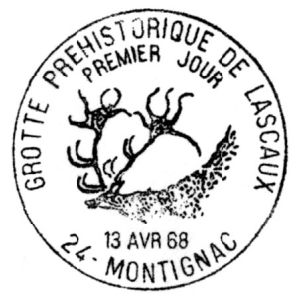 |
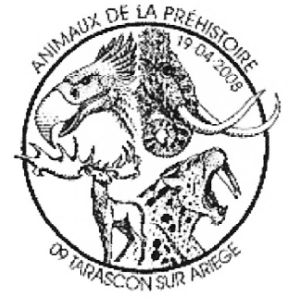 |
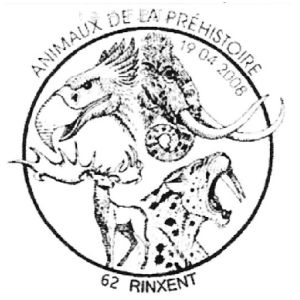 |
| France 1968 | France 2008 | |
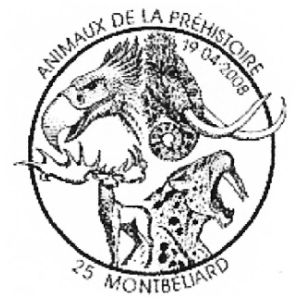 |
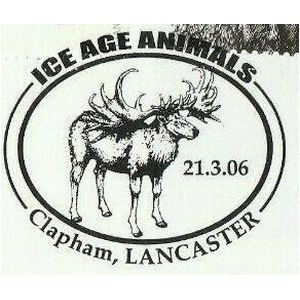 |
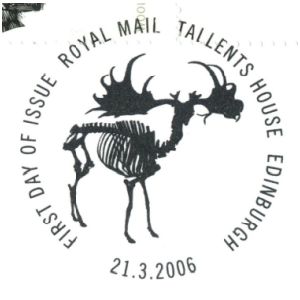 |
| France 2008 | Great Britain 2006 | |
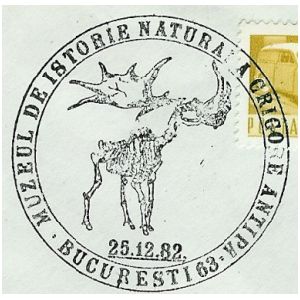 |
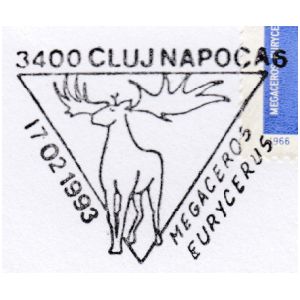 |
|
| Romania 1982 | Romania 1993 | |
Megaloceros giganteus on cachets of FDC and Maximum and Post Cards.
The FDC of Great Britain and Maxi and Post Cards of Russia are personalized products, many other variants exist. |
 |
 |
| Great Britain 2006 | Moldova 2016 | |
 |
 |
 |
| Transnitria (Moldova) 2015 | Russia 2020 | |
Acknowledgement

|
- Many thanks to Dr. Peter Voice from Department of Geological and Environmental Sciences, Western Michigan University, for reviewing the draft page, his valuable comments and great help to find materials for this article.
- Many thanks to Mr. Nigel T. Monaghan, Keeper of Natural History Division National Museum of Ireland and Mrs. Laura McCoy, Curator of Natural History in Manx Museum of the Isle of Man for their help in finding information for this article.
- Many thanks to Mr. Kevin Nolis, Administrator of the “Société d'Histoire Régionale de Rance – Musée du Marbre” and former Secretary of the Belgian Paleontological Association, for his help in finding information for this article and for reviewing the draft page.
- Many thanks to fellow collector Peter Brandhuber from Germany (who run Evolution of mankind and Philately group on Facebook ) for his help to finding information about the unadopted Irish stamp.
Notes:
- The first version of this article was created in 2020 and uploaded on the website as two PDF files: "First discoveries Megaloceros giganteus" and "First discoveries Megaloceros giganteus in Russia".
- In 2024 both PDFs were merged into this article, then updated.
References:
-
General information about Megaloceros giganteus:
NHM UK, Encyclopedia Britannica, Wikipedia, New World Encyclopedia, Berkley University of California. -
Discoveries of Megaloceros giganteus in Ireland:
- Mu-Log: “THE IRISH ELK (CERVUS MEGACEROS)”
- “Essay on the THEORY OF THE EARTH, BY Baron G. Cuvier, Perpetual Secretary of the French Institute, Professor and Administrator of the Museum of Natural History WITH GEOLOGICAL ILLUSTRATIONS by PROFESSOR JAMESON, Fifth Edition, William Blackwood, Edinburgh; and T. Cadell, Strand, London. 1827", pages 486-507.
- “The Giant Deer in Ireland (Studies in Irish Quaternary Deposits: No. 6)”
- “A description of the skeleton of the fossil deer of Ireland, Cervus megaceros”, by John Hart, published in 1825.
- Monography “BRITISH PLEISTOCENE MAMMALIA” published in 1927 by SIDNEY H. REYNOLDS, M.A., Sc.D., F.G.S. PROFESSOR OF GEOLOGY IN THE UNIVERSITY OF BRISTOL
- "A history of British fossil mammals and birds”, Richard Owen, published in 1846, pages 447-448
- “Megaloceros, the ice age giant deer of Ireland and some Dutch connections.”, by Nigel T Monaghan
- “On Irish Elk and Other Animal Remains Found at Howth and Ballybetagh, Co. Dublin”, by Henry Stokes , published in The Irish Naturalist, vol. 23 in May 1914, pages 113-118.
- Independent.ie: “Treasures: Ancient beast's antlers to lure deer hunters”
- “Taxonomic problem of the giant deer Megaloceros giganteus”.
- „The Irish Elk: The Ice, Air and Steel“
-
Discoveries of Megaloceros giganteus on the Isle of Man:
- Isleofman.com: Cervus giganteus in the Isle of Man
- “The Ballaugh Elk of 1819”, second edition, by Joy Ling. Issued in 2014 by Ballaugh Heritage Trust on Isle of Man.
- Discoveries of Megaloceros giganteus in Germany:
-
Early study of Megaloceros giganteus
- "Handbuch der Naturgeschichte. 6. Aufl. Göttingen", by Johann Friedrich Blumenbach, page 697.
- "A catalogue of the ana tomical and zoological museum of Joshua Brooks", published by British naturalist Joshua Brooks on 1828.
- “Extinct Monsters” by Hutchinson, published in 1896, chapter XVI page 243
- “Worlds Before Adam: The Reconstruction of Geohistory in the Age of Reform”, By Martin J. S. Rudwick, (page 201)
-
Discoveries of Megaloceros giganteus in Russia (in Russian):
Yekaterinburg- Regional Natural History Museum in Yekaterinburg: Uarloved.
- “НАУЧНЫЙ ОБЗОРЪ. Сибирско-Уральская научно-промышленная выставка въ Екатеринбургѣ и VII-й археологическій съѣздъ въ Ярославлѣ.” by Анучин Дмитрий Николаевич, published in "Русская Мысль", кн.XI, 1887
- Сибирско-Уральская научно-промышленная выставка 1887 г. в г. Екатеринбурге: [приложение к "Екатеринбургской неделе", 1887 г.]
- „Записки Уральского общества любителей естествознания Т 10 Вып. 4“, issues in Yekaterinburg in 1889, pages 74 and 81
- "Записки Уральского общества любителей естествознания. Т. 10. Вып. 4. Материалы о Сибирско-Уральской научно-промышленной выставке 1887 г."
- Photo gallery from the Siberian-Ural Scientific and Industrial Exhibition in 1887: zavodfoto.livejournal
Sapozhek by Ryazan:- “Гигантский олень мегалоцерос”, by Anton Nelichov
- M. V. Pavlova, P.P. Stakhanov, M.D. Malinina “Находки Гигантского Оленя (Cervus Mefaceros) в Рюзанской губернии", piblished in Ryazan in 1929
- Local History Museum in Sapozhek: Official website Media Ryazan about Local History Museum in Sapozhek
- gazeta.ru: “В погоне за большерогим оленем"